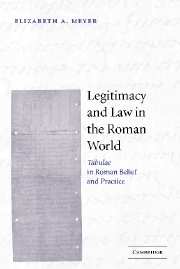Book contents
- Frontmatter
- Contents
- List of illustrations
- Acknowledgments
- List of abbreviations
- Introduction
- Part One THE WORLD OF BELIEF
- Chapter 1 The use and value of Greek legal documents
- Chapter 2 Roman perceptions of Roman tablets: aspects and associations
- Chapter 3 The Roman tablet: style and language
- Chapter 4 Recitation from tablets
- Chapter 5 Tablets and efficacy
- Part Two THE EVOLUTION OF PRACTICE
- Conclusion
- References
- Index
Chapter 3 - The Roman tablet: style and language
Published online by Cambridge University Press: 22 September 2009
- Frontmatter
- Contents
- List of illustrations
- Acknowledgments
- List of abbreviations
- Introduction
- Part One THE WORLD OF BELIEF
- Chapter 1 The use and value of Greek legal documents
- Chapter 2 Roman perceptions of Roman tablets: aspects and associations
- Chapter 3 The Roman tablet: style and language
- Chapter 4 Recitation from tablets
- Chapter 5 Tablets and efficacy
- Part Two THE EVOLUTION OF PRACTICE
- Conclusion
- References
- Index
Summary
In their various aspects and associations, Roman tablets can be seen to share a number of characteristics. This perceived resemblance can be reinforced and extended by an examination of the Latin written on these tablets, for all writing on tablets shares three unusual traits that separate it off from everyday Latin. First, its style and syntax are not those of the everyday: they correspond much more closely to the style and syntax of what philosophers of language call “formalized” language. The definition of this “voice of traditional authority” arrived at by the anthropologist Maurice Bloch is most applicable here: such language is an “impoverished language” in which “choice of form, of style, of words and of syntax is less than in ordinary language” – by consciously following certain patterns, others are excluded. Second, this formulaic language was recognized as archaic or archaizing, its set forms (and spellings) redolent of the past but modifiable through general agreement or for particular circumstances as long as that old-time flavor was retained. Finally, all writing on tablets shared components that went by the same names, formula, ordo, and nomen, and was characteristically subject to extensive abbreviation and parody.
- Type
- Chapter
- Information
- Legitimacy and Law in the Roman WorldTabulae in Roman Belief and Practice, pp. 44 - 72Publisher: Cambridge University PressPrint publication year: 2004

